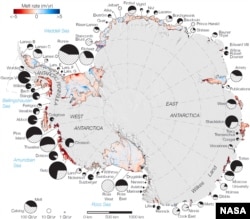Most of the loss Antarctic ice is not caused by icebergs falling apart into the sea, but instead by warmer ocean waters underneath the massive ice shelves causing melting, according to a new study by NASA and university researchers.
The study found that so-called basal melt accounted for 55 percent of all ice shelf mass loss from 2003 to 2008. Using reconstructions of ice accumulation as well as satellite and aircraft readings of ice thickness and changes in elevations, scientists were able to compare the speed of ice shelf melt versus that of calving, or the splitting of icebergs.
"The traditional view on Antarctic mass loss is it is almost entirely controlled by iceberg calving," said Eric Rignot of NASA's Jet Propulsion Laboratory in Pasadena, Calif.
"Our study shows melting from below by the ocean waters is larger, and this should change our perspective on the evolution of the ice sheet in a warming climate," said Rignot, lead author of the study to be published in the June 14 issue of the journal Science.
According to NASA, the Antarctic ice shelves lost 1,325 trillion kilograms of ice per year in 2003 to 2008 through basal melt, while calving accounted for 1,089 trillion kilograms of mass loss each year.
Determining how the ice is melting will help scientists improve models on how the Antarctic ice sheet will evolve with warming ocean temperatures, including how it could contribute to sea level rise and changing ocean circulation.
"Changes in basal melting are helping to change the properties of Antarctic bottom water, which is one component of the ocean's overturning circulation," said another study author, Stan Jacobs, an oceanographer at Columbia University's Lamont-Doherty Earth Observatory in Palisades, New York. "In some areas it also impacts ecosystems by driving coastal upwelling, which brings up micronutrients like iron that fuel persistent plankton blooms in the summer."
The rate of basal melting varies around the continent. The three giant ice shelves - Ross, Filchner and Ronne, which make up two-thirds of the total Antarctic ice shelf area - accounted for only 15 percent of basal melting. Smaller ice shelves produced half of the basal melt over the period studied, NASA said.
"Ice shelf melt doesn't necessarily mean an ice shelf is decaying. It can be compensated by the ice flow from the continent," Rignot said. "But in a number of places around Antarctica, ice shelves are melting too fast, and a consequence of that is glaciers, and the entire continent, are changing as well."
The study found that so-called basal melt accounted for 55 percent of all ice shelf mass loss from 2003 to 2008. Using reconstructions of ice accumulation as well as satellite and aircraft readings of ice thickness and changes in elevations, scientists were able to compare the speed of ice shelf melt versus that of calving, or the splitting of icebergs.
"The traditional view on Antarctic mass loss is it is almost entirely controlled by iceberg calving," said Eric Rignot of NASA's Jet Propulsion Laboratory in Pasadena, Calif.
"Our study shows melting from below by the ocean waters is larger, and this should change our perspective on the evolution of the ice sheet in a warming climate," said Rignot, lead author of the study to be published in the June 14 issue of the journal Science.
According to NASA, the Antarctic ice shelves lost 1,325 trillion kilograms of ice per year in 2003 to 2008 through basal melt, while calving accounted for 1,089 trillion kilograms of mass loss each year.
Determining how the ice is melting will help scientists improve models on how the Antarctic ice sheet will evolve with warming ocean temperatures, including how it could contribute to sea level rise and changing ocean circulation.
"Changes in basal melting are helping to change the properties of Antarctic bottom water, which is one component of the ocean's overturning circulation," said another study author, Stan Jacobs, an oceanographer at Columbia University's Lamont-Doherty Earth Observatory in Palisades, New York. "In some areas it also impacts ecosystems by driving coastal upwelling, which brings up micronutrients like iron that fuel persistent plankton blooms in the summer."
The rate of basal melting varies around the continent. The three giant ice shelves - Ross, Filchner and Ronne, which make up two-thirds of the total Antarctic ice shelf area - accounted for only 15 percent of basal melting. Smaller ice shelves produced half of the basal melt over the period studied, NASA said.
"Ice shelf melt doesn't necessarily mean an ice shelf is decaying. It can be compensated by the ice flow from the continent," Rignot said. "But in a number of places around Antarctica, ice shelves are melting too fast, and a consequence of that is glaciers, and the entire continent, are changing as well."









